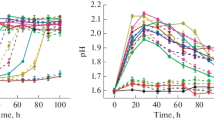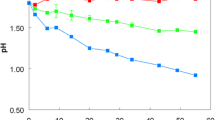Abstract
Two strains ofLeptospirillum-like bacteria, L6 and L8, have been isolated from a mixed inoculum, also containingThiobacillus ferrooxidans andT. thiooxidans, cultured for one year with a colbaltiferous pyrite as energy substrate in a 100 I continuous bioleaching laboratory unit. Several physiological properties of the strains are described. The vibrio-shaped microorganisms grew at pH values lower than 1.3. Their growth rate was maximum between 2.5 and 8.0 g l1 ferrous iron. The optimal growth temperature was 37.5° C. Ferric iron had a stimulative effect on bacterial development up to 8 g l−1, and growth was as rapid at 14 g l−1 ferric iron as at 8 g l−1. The negative influence of cobalt on the final cell concentration was observed at 0.5 g l−1, but the growth rate was not affected up to 2 g l−1. The G + C content of strains L8 is 55.6 mol%.
Similar content being viewed by others
References
Balashova VV, Vedenina IYa, Markosyan GE & Zavarzin GA (1975) The auxotrophic growth ofLeptospirillum ferrooxidans. Mikrobiologyia Engl. Tr. 43: 491–494
Barrett J, Hughes MN, Karavaiko GI & Spencer PA (1993) Metal extraction by bacterial oxidation of minerals. Hellis Horwood Ltd Publishers, Chichester, England
Charlot G (1966) Les méthodes de la chimie analytique, analyse quantitative minérale. 5th ed. Masson et Cie (Eds) Paris, France
Collinet-Latil MN (1989) Lixiviation bactérienne parThiobacillus ferrooxidans etThiobacillus thiooxidans d'un concentré de flottation arsénopyriteux aurifère (réfractaire à la cyanuration directe). Thèse de Doctorat d'Université. Marseille
Collinet MN & Morin D (1990) Characterization of arsenopyrite oxidizingThiobacillus. Tolerance to arsenite, arsenate, ferrous and ferric iron. Antonie van Leeuwenhoek 57: 237–244
Harrison Jr AP & Norris PR (1985)Leptospirillum ferrooxidans and similar bacteria: some characteristic and genomic diversity. FEMS Microbiol. Lett. 30: 99–102
Helle U & Onken U (1988) Continuous bacterial leaching of a pyritic concentrate byLeptospirillum-like bacteria. Appl. Microbiol. Biotechnol. 28: 553–558
Johnson DB, Macvicar JMH & Rolfe S (1987) A new solid medium for the isolation and enumeration ofThiobacillus ferrooxidans and acidophilic heterotrophic bacteria. J. Microbiol. Meth. 7: 9–18
Johnson DB (1991) Biological desulfurization of coal using mixed populations of mesophilic and moderately acidophilic bacteria. In: Dugan PR, Quigley DR & Attia YA (Eds) Processing and Utilization of High-Sulfur Coals IV (pp. 567–576) Elsevier Science Publishers BV, Amsterdam
Markosyan GE (1972) A new iron-oxidizing bacteriumLeptospirillum ferrooxidans gen. and sp. nov. Biol. Zh. Arm. 25: 26
Merretig U, Wlotzka P & Onken U (1989) Removal of pyritic sulfur from coal byLeptospirillum-like bacteria. In: Salley J, McCready RGL & Wichlacz PL (Eds) Biohydrometallurgy Proceedings of the International Symposium (pp. 761–771) Jackson Hole, Wyoming
Mesbah M, Premachandran U & Whitman W (1989) Precise measurement of the G + C content of deoxyribonucleic acid by high-performance liquid chromatography. Int. J. Syst. Bact. 39: 159–167
Morin D, Battaglia F & Ollivier P (1993) Study of the bioleaching of a cobaltiferous pyritic concentrate. In: Torma AE, Wey JE, Lakshmanan VI (Eds) Biohydrometallurgical Technologies: I. Bioleaching Processes. Proceedings of the International Symposium (pp. 147–156) Jackson Hole, Wyoming
Norris PR (1983) Iron and mineral oxidation withLeptospirillum-like bacteria. In: Rossi G & Torma AE (Eds) Recent Progress in Biohydrometallurgy (pp. 83–96) Cagliari, Italy
Norris PR, Barr DW & Hinson D (1987) Iron and mineral oxidation by acidophilic bacteria: affinities for iron and attachment to pyrite. In: Norris PR & Kelly DP (Eds) Biohydrometallurgy Proceedings of the International Symposium (pp. 43–39) Warwick, UK
Pivovarova TA, Markosyan GE & Karavaiko GI (1981) Morphogenesis and fine structure ofLeptospirillum ferrooxidans. Mikrobiologyia Eng. Tr. 50: 339–343
Sand W, Rohde K, Sobotke B & Zenneck C (1992) Evaluation ofLeptospirillum ferrooxidans for leaching. Appl. Environ. Microbiol. 58: 85–92
Silverman MP & Lundgren DC (1959) Studies on the chemoautotrophic iron-bacteriaFerrobacillus ferrooxidans: I. An improved medium and a harvesting procedure for securing high cell yields. J. Bacteriol. 77: 642–647
Tamaoka J & Komagata K (1984) Determination of DNA base composition by reversed-phase high-performance chromatography. FEMS Microbiol. Lett. 25: 125–128
Visca P, Bianchi E, Polidoro M, Buonfiglio V, Valenti P & Orsi N (1989) A new solid medium for isolating and enumeratingThiobacillus ferrooxidans. J. Gen. Appl. Microbiol. 35: 71–81
Visuvanathan S, Moss MT, Stanford JL, Hermon-Taylor J & McFadden J Jo (1989) Simple enzymatic method for isolation of DNA from diverse bacteria. J. Microbiol. Meth. 10: 59–64
Author information
Authors and Affiliations
Rights and permissions
About this article
Cite this article
Battaglia, F., Morin, D., Garcia, JL. et al. Isolation and study of two strains ofLeptospirillum-like bacteria from a natural mixed population cultured on a cobaltiferous pyrite substrate. Antonie van Leeuwenhoek 66, 295–302 (1994). https://doi.org/10.1007/BF00882763
Received:
Accepted:
Issue Date:
DOI: https://doi.org/10.1007/BF00882763




